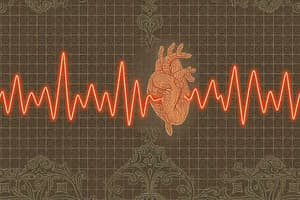Podcast
Questions and Answers
What is ventricular tachycardia?
What is ventricular tachycardia?
- Regular heart rhythm
- Slow heart rate
- Chaotic heart rhythm
- Rapid heart rate with a tendency to transition into Fib (correct)
Which rhythm is indicated by chaotic rhythm originating in the ventricles, resulting in no cardiac output?
Which rhythm is indicated by chaotic rhythm originating in the ventricles, resulting in no cardiac output?
ventricular fibrillation
What is the indicator of paced ventricular rhythm?
What is the indicator of paced ventricular rhythm?
vertical spike before QRS complex
What is the characteristic of wandering pacemaker?
What is the characteristic of wandering pacemaker?
What is the rhythm characterized by increased ventricular automaticity and reentry phenomenon with PVCs arriving early?
What is the rhythm characterized by increased ventricular automaticity and reentry phenomenon with PVCs arriving early?
What is the ventricular rate range for idioventricular rhythm?
What is the ventricular rate range for idioventricular rhythm?
What are the characteristics of accelerated idioventricular rhythm?
What are the characteristics of accelerated idioventricular rhythm?
What describes 2nd degree AV block 2:1 conduction?
What describes 2nd degree AV block 2:1 conduction?
What characterizes 3rd degree AV block?
What characterizes 3rd degree AV block?
What arises from an irritable focus within the AV junction?
What arises from an irritable focus within the AV junction?
Flashcards are hidden until you start studying
Study Notes
Ventricular Tachycardia
- Characterized by a rapid heart rate; may lead to ventricular fibrillation (Fib).
- Recognized for its potential progression into more severe rhythms.
Ventricular Fibrillation
- A chaotic rhythm from the ventricles leading to no effective cardiac output.
- Height of QRS complexes must be 3mm or more for successful defibrillation; lower heights indicate reduced chances.
Paced Ventricular Rhythm
- Identified by a vertical spike preceding the QRS complex.
- Indicates pacing of the ventricles, suggesting external stimulation for heart rhythm regulation.
Wandering Pacemaker
- Involves varying locations of electrical impulses, resulting in three or more distinct P waves.
- Associated with narrow QRS complexes, indicating normal conduction through the ventricles.
Sinus Rhythm with PVC
- Features increased ventricular automaticity with premature ventricular contractions (PVCs).
- PVCs present early, often appear wide on the ECG, indicating a deviation from normal ventricular depolarization.
Idioventricular Rhythm
- Occurs when the SA and AV nodes are inactive or firing slower than the ventricular pacemaker.
- Heart rate ranges between 20-40 beats per minute, indicating bradycardia.
Accelerated Idioventricular Rhythm
- Shows a heart rate ranging from 40 to 100 bpm with a regular pattern.
- P-waves are absent; QRS complexes appear wide and bizarre; PR intervals are not present, suggesting ectopic ventricular activation.
2nd Degree AV Block 2:1 Conduction
- A specific occurrence where every alternate P wave does not have a corresponding QRS complex.
- Represents a disruption in normal atrioventricular conduction.
3rd Degree AV Block
- Characterized by P waves that occur independently of QRS complexes, leading to chaotic PR intervals.
- A narrow QRS indicates a higher junctional block; a wide QRS suggests a blockage higher up in the Bundle Branches.
Premature Junctional Complex
- Results from an irritable focus within the AV junction.
- Characterized by absent or inverted P waves and a shortened PR interval, indicating abnormal conduction patterns originating from the junctional tissue.
Studying That Suits You
Use AI to generate personalized quizzes and flashcards to suit your learning preferences.




